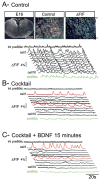Brain-derived neurotrophic factor enhances fetal respiratory rhythm frequency in the mouse preBötzinger complex in vitro
- PMID: 18702723
- PMCID: PMC2664708
- DOI: 10.1111/j.1460-9568.2008.06345.x
Brain-derived neurotrophic factor enhances fetal respiratory rhythm frequency in the mouse preBötzinger complex in vitro
Abstract
Brain-derived neurotrophic factor (BDNF) is required during the prenatal period for normal development of the respiratory central command; however, the underlying mechanisms remain unknown. To approach this issue, the present study examined BDNF regulation of fetal respiratory rhythm generation in the preBötzinger complex (preBötC) of the mouse, using transverse brainstem slices obtained from prenatal day 16.5 animals. BDNF application (100 ng/mL, 15 min) increased the frequency of rhythmic population activity in the preBötC by 43%. This effect was not observed when preparations were exposed to nerve growth factor (100 ng/mL, 30 min) or pretreated with the tyrosine kinase inhibitor K252a (1 h, 200 nm), suggesting that BDNF regulation of preBötC activity requires activation of its cognate tyrosine receptor kinase, TrkB. Consistent with this finding, single-cell reverse transcription-polymerase chain reaction experiments showed that one third of the rhythmically active preBötC neurons analysed expressed TrkB mRNA. Moreover, 20% expressed BDNF mRNA, suggesting that the preBötC is both a target and a source of BDNF. At the network level, BDNF augmented activity of preBötC glutamatergic neurons and potentiated glutamatergic synaptic drives in respiratory neurons by 34%. At the cellular level, BDNF increased the activity frequency of endogenously bursting neurons by 53.3% but had no effect on basal membrane properties of respiratory follower neurons, including the Ih current. Our data indicate that BDNF signalling through TrkB can acutely modulate fetal respiratory rhythm in association with increased glutamatergic drive and bursting activity in the preBötC.
Figures





References
Publication types
MeSH terms
Substances
Grants and funding
LinkOut - more resources
Full Text Sources

